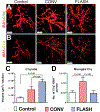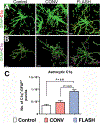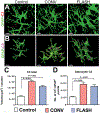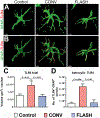Ultra-High-Dose-Rate FLASH Irradiation Limits Reactive Gliosis in the Brain
- PMID: 32853387
- PMCID: PMC7856066
- DOI: 10.1667/RADE-20-00067.1
Ultra-High-Dose-Rate FLASH Irradiation Limits Reactive Gliosis in the Brain
Abstract
Encephalic radiation therapy delivered at a conventional dose rate (CONV, 0.1-2.0 Gy/min) elicits a variety of temporally distinct damage signatures that invariably involve persistent indications of neuroinflammation. Past work has shown an involvement of both the innate and adaptive immune systems in modulating the central nervous system (CNS) radiation injury response, where elevations in astrogliosis, microgliosis and cytokine signaling define a complex pattern of normal tissue toxicities that never completely resolve. These side effects constitute a major limitation in the management of CNS malignancies in both adult and pediatric patients. The advent of a novel ultra-high dose-rate irradiation modality termed FLASH radiotherapy (FLASH-RT, instantaneous dose rates ≥106 Gy/s; 10 Gy delivered in 1-10 pulses of 1.8 µs) has been reported to minimize a range of normal tissue toxicities typically concurrent with CONV exposures, an effect that has been coined the "FLASH effect." Since the FLASH effect has now been found to significantly limit persistent inflammatory signatures in the brain, we sought to further elucidate whether changes in astrogliosis might account for the differential dose-rate response of the irradiated brain. Here we report that markers selected for activated astrogliosis and immune signaling in the brain (glial fibrillary acidic protein, GFAP; toll-like receptor 4, TLR4) are expressed at reduced levels after FLASH irradiation compared to CONV-irradiated animals. Interestingly, while FLASH-RT did not induce astrogliosis and TLR4, the expression level of complement C1q and C3 were found to be elevated in both FLASH and CONV irradiation modalities compared to the control. Although functional outcomes in the CNS remain to be cross-validated in response to the specific changes in protein expression reported, the data provide compelling evidence that distinguishes the dose-rate response of normal tissue injury in the irradiated brain.
©2020 by Radiation Research Society. All rights of reproduction in any form reserved.
Figures





Similar articles
-
Maintenance of Tight Junction Integrity in the Absence of Vascular Dilation in the Brain of Mice Exposed to Ultra-High-Dose-Rate FLASH Irradiation.Radiat Res. 2020 Dec 1;194(6):625-635. doi: 10.1667/RADE-20-00060.1. Radiat Res. 2020. PMID: 33348373 Free PMC article.
-
Ex vivo brain MRI to assess conventional and FLASH brain irradiation effects.Radiother Oncol. 2025 Jul;208:110894. doi: 10.1016/j.radonc.2025.110894. Epub 2025 Apr 14. Radiother Oncol. 2025. PMID: 40233872
-
FLASH Irradiation Results in Reduced Severe Skin Toxicity Compared to Conventional-Dose-Rate Irradiation.Radiat Res. 2020 Dec 1;194(6):618-624. doi: 10.1667/RADE-20-00090. Radiat Res. 2020. PMID: 32853385 Free PMC article.
-
[Flash radiotheray at very high dose-rate: A brief account of the current situation].Cancer Radiother. 2019 Oct;23(6-7):674-676. doi: 10.1016/j.canrad.2019.07.127. Epub 2019 Aug 13. Cancer Radiother. 2019. PMID: 31420128 Review. French.
-
Clinical translation of ultra-high dose rate flash radiotherapy: Opportunities, challenges, and prospects.World J Radiol. 2025 Apr 28;17(4):105722. doi: 10.4329/wjr.v17.i4.105722. World J Radiol. 2025. PMID: 40309475 Free PMC article. Review.
Cited by
-
Current views on mechanisms of the FLASH effect in cancer radiotherapy.Natl Sci Rev. 2024 Sep 30;11(10):nwae350. doi: 10.1093/nsr/nwae350. eCollection 2024 Oct. Natl Sci Rev. 2024. PMID: 39479528 Free PMC article. Review.
-
A potential revolution in cancer treatment: A topical review of FLASH radiotherapy.J Appl Clin Med Phys. 2022 Oct;23(10):e13790. doi: 10.1002/acm2.13790. Epub 2022 Sep 27. J Appl Clin Med Phys. 2022. PMID: 36168677 Free PMC article. Review.
-
Development of a Single-Neurosphere Culture to Assess Radiation Toxicity and Pre-Clinical Cancer Combination Therapy Safety.Cancers (Basel). 2023 Oct 10;15(20):4916. doi: 10.3390/cancers15204916. Cancers (Basel). 2023. PMID: 37894283 Free PMC article.
-
Comparable Long-Term Tumor Control for Hypofractionated FLASH Versus Conventional Radiation Therapy in an Immunocompetent Rat Glioma Model.Adv Radiat Oncol. 2022 Jul 2;7(6):101011. doi: 10.1016/j.adro.2022.101011. eCollection 2022 Nov-Dec. Adv Radiat Oncol. 2022. PMID: 36092986 Free PMC article.
-
Key changes in the future clinical application of ultra-high dose rate radiotherapy.Front Oncol. 2023 Oct 24;13:1244488. doi: 10.3389/fonc.2023.1244488. eCollection 2023. Front Oncol. 2023. PMID: 37941555 Free PMC article.
References
-
- Harrington KJ. Ultrahigh dose-rate radiotherapy: Next steps for FLASH-RT. Clin Cancer Res 2019; 25:3–5. - PubMed
-
- Montay-Gruel P, Bouchet A, Jaccard M, Patin D, Serduc R, Aim W, et al. X-rays can trigger the FLASH effect: Ultra-high dose-rate synchrotron light source prevents normal brain injury after whole brain irradiation in mice. Radiother Oncol 2018; 129:582–8. - PubMed
-
- Montay-Gruel P, Petersson K, Jaccard M, Boivin G, Germond JF, Petit B, et al. Irradiation in a flash: Unique sparing of memory in mice after whole brain irradiation with dose rates above 100 Gy/s. Radiother Oncol 2017; 124:365–9. - PubMed

